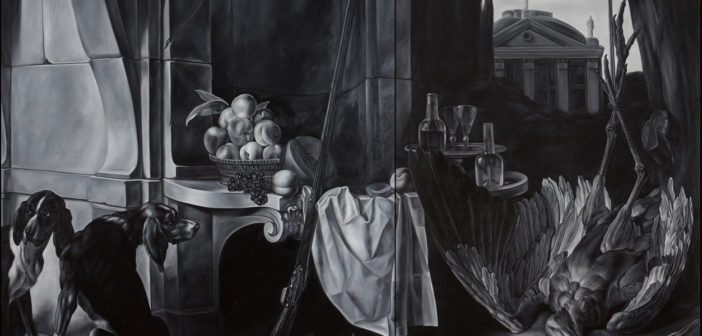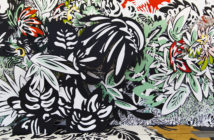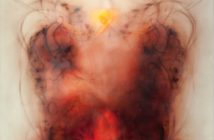Paranoia has a way of creeping up the spine and burrowing into the brain. Like a tick in the woods waiting for the right moment to latch onto its next host, it feeds—gorging itself on suspicions of falsehoods, naivety, and manipulated truths.
Digesting Shelley Reed’s paintings felt a lot like discovering that tick on the back of your leg hours after a jaunt through the woods. With the utmost conviction, the tick quietly clung to its chosen host, fastened itself within the layers of fleshy epidermis, and fed until its swollen body pulsed with excess. Fortunately, Reed’s paintings do not carry Lyme disease or Rocky Mountain spotted fever. However, they infect the viewer with something much more revealing of its source and equally uncomfortable to contract. Contextualized by the looming crescendo of the information age, Reed’s exhibited work at the Fitchburg Art Museum begged the question: are curiosity and paranoia two sides of the same coin?
Just recently closed, A Curious Nature was comprised of regional artist Shelley Reed’s most recent work. Predominantly consisting of her enormous grisaille paintings on canvas and paper, the work contains specific characters and imagery deriving from the likes of seventeenth- and eighteenth-century painters such as Jean-Baptiste Oudry, Alexandre-François Desportes, and Melchior d’Hondecoeter.
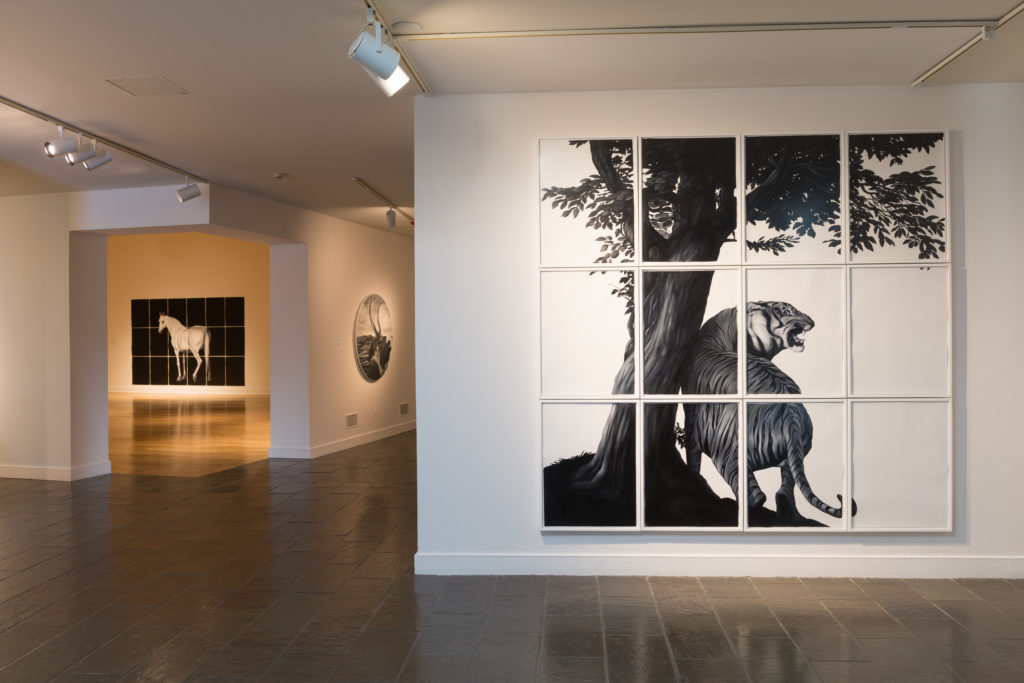
Shelley Reed, Tiger (after Janssens and Landseer), 2017, oil on paper, 90 x 88 inches; White Horse (after Grant and Stubbs), 2016, oil on paper, 90 x 132 inches; City Bound (after Ward and Breenbergh), 2014, oil on canvas, 48-inch diameter. Installation view, A Curious Nature: Paintings by Shelley Reed, Fitchburg Art Museum. Courtesy of Danese/Corey. ©2017 Charles Sternaimolo.
With meticulous visual description, Reed’s paintings oscillate our attention between her elaborately composed allegorical scenes, such as In Dubious Battle, and her dramatically isolated subjects, as seen in White Horse (after Grant and Stubbs). The two styles of composition are diametrically dispersed throughout the galleries. Organized by curators Lisa Crossman and Mary Tinti, the intuitive layout accentuates the artist’s varying narrative structures, almost as a means of psychologically zooming in and out of each painting’s proposed perspective. The combination of this visual and narrative tactic makes it all-too-easy to forget the fact that most of Reed’s subjects are in fact animal, not human—each containing their own palpable psychologies to be reckoned with.
If the “zooming in and out” of a zoo full of allegorical paintings and depictions of highly emotionalized animals wasn’t disorienting enough, try looking one of her subjects in the eyes. The theatricality and intensity of their staged interactions seem to pause for only a brief moment as the viewer takes a loud gulp and experiences the nagging feeling that—perhaps—Reed’s subjects have been observing the viewer, as much as the viewer has been observing them. These encounters feel alarmingly intimate, yet arouse a suspicion of psychological espionage that goes beyond the dusty tradition of allegorical painting and speaks with contemporary instinct and foresight.
Reed’s chosen art historical sources reference what was a budding interest in nature, science, and the animal world specific to Northern European art of the time. Allegorical depictions of animals transformed each animal into symbolic characters capable of narrative. For instance, peacocks (another character Reed utilizes) were often used to represent vanity. Recontextualized by the artist’s deliberate manipulation of scene and scale, Reed’s appropriated characters experience new life and new meaning. With every reimagined feathered wing, tensed hind leg, and foaming snarl, the artist’s “borrowed” subjects are transformed into tangible beings liberated by their depictions of autonomous personality and agency. In this vein, Reed’s animals are both plucked from their art historical sources and thoughtfully recontextualized as their historic symbolism grapples with their current context.
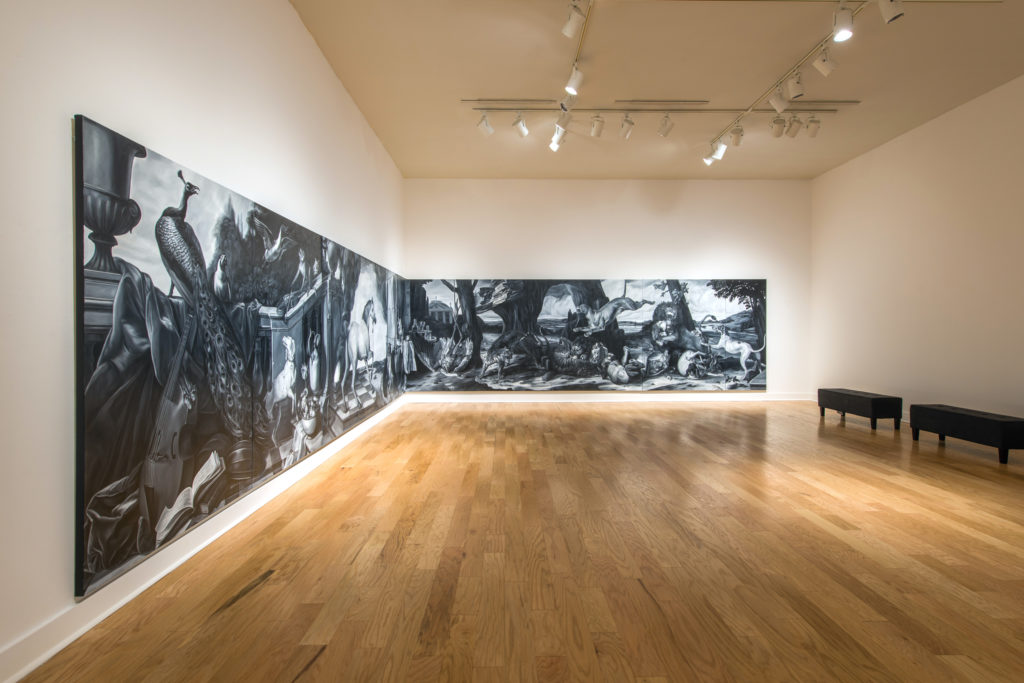
Shelley Reed, In Dubious Battle, 2013, oil on
canvas, 84 x 564 inches (11 panels,
attribution to 23 artists). Courtesy of Danese/
Corey. ©2017 Charles Sternaimolo.
Possibly her most ambitious exhibited piece, In Dubious Battle wrapped around two perpendicular walls in the left-hand corner of the gallery. Spanning forty-seven feet, the eleven connected canvases depict a chaotic narrative starring twenty-two animals all engaging in various moments of emotional intensity, conflict, and crises. But what was most alarming is that their distress is so acutely consistent with aspects of human psychology in the face of crisis, making the experience of these visualized scenarios all the more poignant.
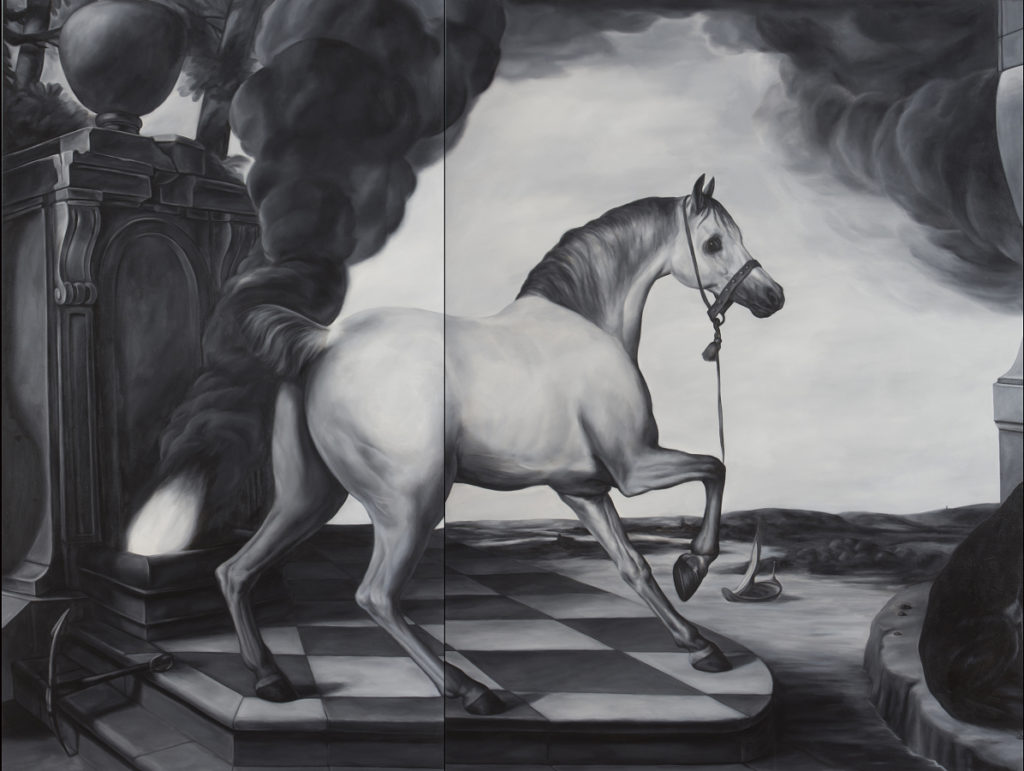
Shelley Reed, detail of In Dubious Battle, 2013, oil on canvas, 84 x 564 inches (11 panels, attribution to 23 artists). Courtesy of Danese/Corey.
In the center of this scene of chaos stands a white horse tangled in its lead rope. Seemingly startled by the shooting blaze smoking behind it, the animal is depicted pulling on its own muzzle in a panic. Despite its terror-stricken expression, the horse’s frozen pose resembles historical sculptures of steeds carrying celebrated war heroes. I found myself contending with American pop culture images of wild horses galloping through Montana pastures and starring in Chevrolet commercials. The image of the horse is historically associated with romantic notions of freedom. Does Reed knowingly play with these associations? If so, what does the contemporary viewer make of this panicked horse, both tangled and stoically posed? Freedom, as depicted here, has been harnessed, humbled, and humiliated by its less glamorous history of domestication and exploitation, which—like this giant white horse—is no longer small enough to sweep under the rug.
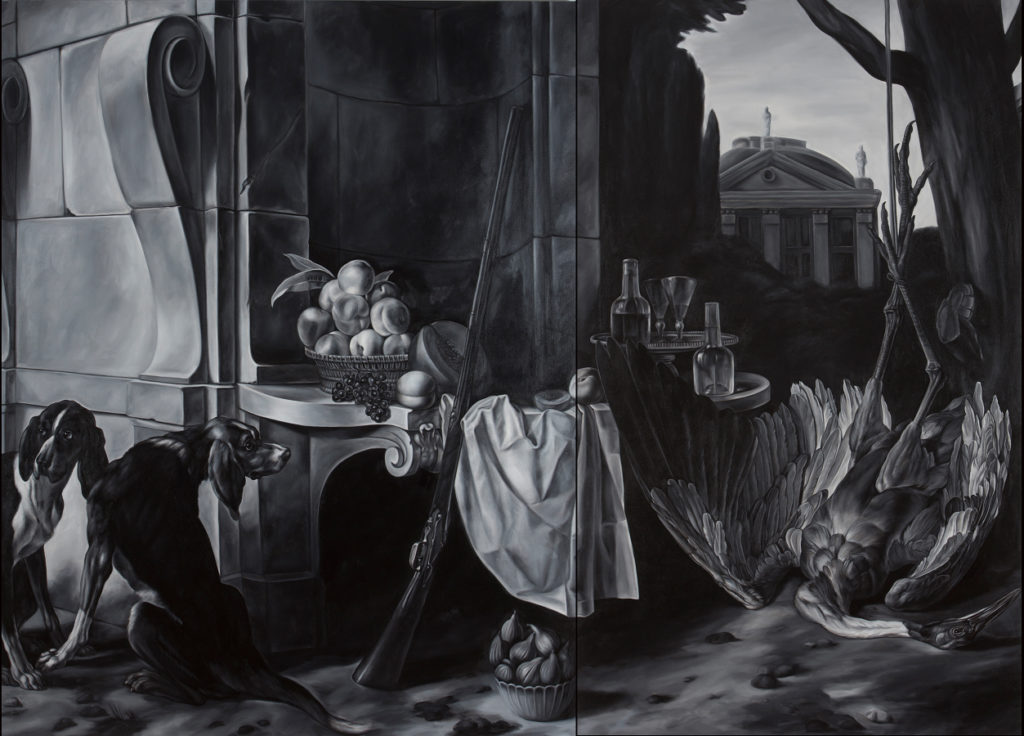
Shelley Reed, detail of In Dubious Battle, 2013, oil on canvas, 84 x 564 inches (11 panels, attribution to 23 artists). Courtesy of Danese/Corey.
Adjacent to the white horse are two hounds, sheepishly looking at their entangled costar. One hound looks back with guilt as the other focuses on a conveniently placed rifle—perhaps considering it as a means to put the stallion out of its misery. Their painted expressions uniquely evoke human admissions of guilt and abandoned responsibility, intimately confessed or otherwise. Historically associated with the English tradition of fox hunting, the hound is symbolic of both the sport of hunting and demonstrations of fidelity. Do Reed’s animals represent a larger narrative specific to the contemporary context in which they are viewed?
Confronted by Reed’s various depictions of psychological chaos, one could eerily be reminded of our own contemporary “dubious battle,” regarding the nauseating tilt-a-whirl of America’s climate of paranoia, speculation, and misinformation. Set in a digital vacuum of ever-accessible (and interchangeable) fact and opinion, allegations of fake news and information hacking are carelessly spun about as more informed methods of social participation dissolve into the internet’s information overload. Reed’s characters and intense visual scenarios ask the viewer: how do you participate in your unfolding narrative? As one reconciles with the increasing appetite to partake in the chaotic “fox hunt” of our time, perhaps it is not too much of a stretch to feel like Reed’s entangled horse pulling on its own muzzle or the repentant hounds questioning their part in the mess. Revealing suggestions of mass participation and exploited paranoia swell the contemporary mind, as In Dubious Battle echoes the psychological infrastructure that engenders the current chaos of our contemporary narrative.
To watch or to be watched? A Curious Nature, camouflaged in a historicized aesthetic, harnesses a particular paranoia and chaos specific to the contemporary experience. Reed’s work relates to relevant contemporary themes of appropriation in the digital age, implications of increased social voyeurism versus the depleted effectiveness of more “authentic” forms of participation, and the bastardization of informed skepticism deriving from the ruthless entanglement of misinformation, spectatorship, and surveillance—all of which have reached a pinnacle point in both socio-political arenas and in the art contemporaneously being made in reaction to it.
With such insight, clarity, and a hint of incredulity imbedded in their theatricality and scale, Shelley Reed’s paintings pulse with vivacity, emotion, and best of all paranoia… saturating the viewer’s thoughts as the tick begins to feed.

